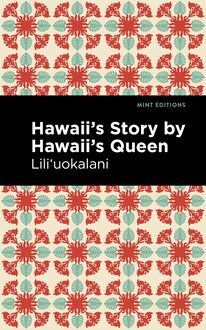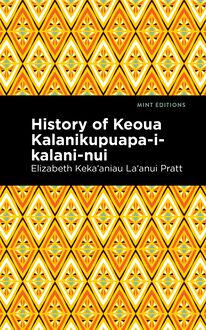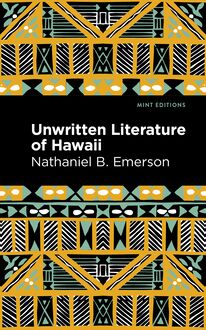-
 Univers
Univers
-
 Ebooks
Ebooks
-
 Livres audio
Livres audio
-
 Presse
Presse
-
 Podcasts
Podcasts
-
 BD
BD
-
 Documents
Documents
-
- Cours
- Révisions
- Ressources pédagogiques
- Sciences de l’éducation
- Manuels scolaires
- Langues
- Travaux de classe
- Annales de BEP
- Etudes supérieures
- Maternelle et primaire
- Fiches de lecture
- Orientation scolaire
- Méthodologie
- Corrigés de devoir
- Annales d’examens et concours
- Annales du bac
- Annales du brevet
- Rapports de stage
La lecture à portée de main
Vous pourrez modifier la taille du texte de cet ouvrage
Découvre YouScribe en t'inscrivant gratuitement
Je m'inscrisDécouvre YouScribe en t'inscrivant gratuitement
Je m'inscrisEn savoir plus
Vous pourrez modifier la taille du texte de cet ouvrage
En savoir plus

Description
Hawaii's Story by Hawaii's Queen is a moving personal portrait of a girl who grew up to become Hawaii’s first and only queen, a beloved monarch who fought for the rights of her people.
Hawaii's Story by Hawaii's Queen is an autobiography by Queen Lili‘uokalani. Published in 1898, the book was written in the aftermath of Lili‘uokalani’s attempt to appeal on behalf of her people to President Grover Cleveland, a personal friend. Although it inspired Cleveland to demand her reinstatement, the United States Congress published the Morgan Report in 1894, which denied U.S. involvement in the overthrow of the Kingdom of Hawaii. Hawaii's Story by Hawaii's Queen appeared four years later as a final effort by Lili‘uokalani to advocate on behalf of Hawaiian sovereignty, but it unfortunately came too late. That same year, President McKinley and the United States Congress approved the annexation of Hawaii.
In Hawaii's Story by Hawaii's Queen, Lili‘uokalani reflects on her experiences as a young girl growing up on Oahu, where she was raised as a member of the extended royal family of King Kamehameha III. Born in Honolulu, she was educated among her fellow royals from a young age. In addition to her studies, Lili‘uokalani developed an artistic sensibility early on, and was fond of both writing and music. She crafted the lyrics to the popular song “Aloha ‘Oe” (1878), just one of the more than 100 songs she would write in her lifetime.
Although her book was unsuccessful as an attempt to advocate for Hawaiian sovereignty and the restoration of the monarchy, it has since been recognized as a moving personal portrait of a girl who grew up to become Hawaii’s first and only queen, a beloved monarch who fought for the rights of her people.
With a professionally designed cover and manuscript, this edition of Lili‘uokalani’s Hawaii's Story by Hawaii's Queen is a classic of Hawaiian literature designed for the modern audience. Add this beautiful edition to your bookshelf, or enjoy the digital edition on any e-book device.
Sujets
Informations
| Publié par | Mint Editions |
| Date de parution | 24 mars 2021 |
| Nombre de lectures | 0 |
| EAN13 | 9781513276908 |
| Langue | English |
| Poids de l'ouvrage | 2 Mo |
Informations légales : prix de location à la page 0,0500€. Cette information est donnée uniquement à titre indicatif conformément à la législation en vigueur.
Extrait
Hawaii’s Story by Hawaii’s Queen
Lili‘uokalani
Hawaii’s Story by Hawaii’s Queen was first published in 1898.
This edition published by Mint Editions 2021.
ISBN 9781513271903 | E-ISBN 9781513276908
Published by Mint Editions®
minteditionbooks.com
Publishing Director: Jennifer Newens
Design & Production: Rachel Lopez Metzger
Project Manager: Micaela Clark
Typesetting: Westchester Publishing Services
Ha‘aheo e ka ua i nā pali
Proudly swept the rain by the cliffs
Ke nihi a‘ela i ka nahele
As it glided through the trees
E hahai (uhai) ana paha i ka liko
Still following ever the bud
Pua ‘āhihi lehua o uka
The ‘āhihi lehua of the vale
Hui:
Chorus:
Aloha ‘oe, aloha ‘oe
Farewell to thee, farewell to thee
E ke onaona noho i ka lipo
The charming one who dwells in the shaded bowers
One fond embrace,
One fond embrace,
A ho‘i a‘e au
Ere I depart
Until we meet again
Until we meet again
‘O ka hali‘a aloha i hiki mai
Sweet memories come back to me
Ke hone a‘e nei i
Bringing fresh remembrances
Ku‘u manawa
Of the past
‘O ‘oe nō ku‘u ipo aloha
Dearest one, yes, you are mine own
A loko e hana nei
From you, true love shall never depart
Tomago:
Refrain:
Maopopo ku‘u ‘ike i ka nani
I have seen and watched your loveliness
Nā pua rose o Maunawili
The sweet rose of Maunawili
I laila hia‘ai nā manu
And ’tis there the birds of love dwell
Miki‘ala i ka nani o ka liko
And sip the honey from your lips
Hui
Chorus
C ONTENTS I. A S KETCH OF M Y C HILDHOOD II. S OME I NCIDENTS OF M Y Y OUTH III. K AMEHAMEHA IV IV. M Y M ARRIED L IFE V. H AWAIIAN M USIC , AND A D UCAL G UEST VI. K AMEHAMEHA V VII. Q UEEN E MMA VIII. K ING K ALAKAUA IX. H EIR A PPARENT X. M Y F IRST V ISIT TO THE U NITED S TATES XI. M AUNA L OA XII. K ALAKAUA’S T OUR OF THE W ORLD XIII. M Y R EGENCY XIV. A S ERIOUS A CCIDENT XV. K ALAKAUA’S R ETURN XVI. C ORONATION C EREMONIES XVII. P RINCESS R UTH AND M RS . B ERNICE P AUAHI B ISHOP XVIII. B ENEVOLENT S OCIETIES XIX. Q UEEN K APIOLANI’S J OURNEY XX. W ASHINGTON —T HE W HITE H OUSE —M OUNT V ERNON XXI. B OSTON AND N EW Y ORK —E N R OUTE FOR E NGLAND XXII. A RRIVAL —L IVERPOOL —S OME E NGLISH T OWNS XXIII. S OVEREIGN OF E NGLAND AND I NDIA XXIV. T HE R ECEPTION AT THE F OREIGN O FFICE XXV. T HE J UBILEE —A T THE A BBEY —A T THE P ALACE XXVI. T HE P RINCE OF W ALES , “G RAND M ASTER ” M ASON XXVII. E NGLAND’S H OMES AND H OSPITALITY XXVIII. I LL N EWS F ROM H AWAII —O UR R ETURN XXIX. “T HE B AYONET C ONSTITUTION ” XXX. I NVITED TO C ONSPIRE A GAINST THE K ING XXXI. T HE K ING T HREATENED AND O PPRESSED XXXII. A TTEMPTED R EVOLUTION XXXIII. T HE K ING’S D EPARTURE —A GAIN R EGENT XXXIV. T HE K ING’S R ETURN —M Y A CCESSION XXXV. T HE L AST S LEEP —L YING IN S TATE XXXVI. M Y C ABINET —P RINCESS K AIULANI XXXVII. M Y H USBAND M ADE P RINCE C ONSORT —H IS D EATH XXXVIII. H AWAIIANS P LEAD FOR A N EW C ONSTITUTION XXXIX. T HE “C RIMES I AM C HARGED W ITHAL ” XL. O VERTHROW OF THE M ONARCHY XLI. S OME I MPORTANT I NQUIRIES XLII. A TTEMPT TO R ESTORE THE M ONARCHY XLIII. I AM P LACED U NDER A RREST XLIV. I MPRISONMENT —F ORCED A BDICATION XLV. B ROUGHT TO T RIAL XLVI. S ENTENCED —M Y P RISON L IFE XLVII. R ELEASED ON P AROLE XLVIII. M R . J OSEPH K AHOOLUHI N AWAHI XLIX. A C HANGE OF S CENE TO F ORGET S ORROW L. A N EW E NGLAND W INTER LI. W ASHINGTON —P SEUDO- H AWAIIANS LII. P RESIDENT AND M RS . C LEVELAND LIII. I NAUGURATION OF P RESIDENT McK INLEY LIV. M Y L ITERARY O CCUPATION LV. M Y O FFICIAL P ROTEST TO THE T REATY LVI. T HE T REATY A NALYZED LVII. H AWAIIAN A UTONOMY A PPENDIX A A PPENDIX B A PPENDIX C A PPENDIX D A PPENDIX E A PPENDIX F A PPENDIX G
I
A S KETCH OF M Y C HILDHOOD
The extinct crater or mountain which forms the background to the city of Honolulu is known as the Punch-Bowl; at its base is situated the Queen’s Hospital, so named because of the great interest taken in its erection by Emma, the queen of Kamehameha IV. Funds for the cause were solicited by the reigning sovereigns in person, and the hospital building was completed in 1860. Very near to its site, on Sept. 2, 1838, I was born. My father’s name was Kapaakea, and my mother was Keohokalole; the latter was one of the fifteen counsellors of the king, Kamehameha III, who in 1840 gave the first written constitution to the Hawaiian people. My great-grandfather, Keawe-a-Heulu, the founder of the dynasty of the Kamehamehas, the Keoua, father of Kamehameha I, were own cousins (he was also brother of Mrs. Bishop’s ancestress, Hakau), and my great-grandaunt was the celebrated Queen Kapiolani, one of the first converts to Christianity. She plucked the sacred berries from the borders of the volcano, descended to the boiling lava, and there, while singing Christian hymns, threw them into the lake of fire. This was the act which broke forever the power of Pele, the fire-goddess, over the hearts of her people. Those interested in genealogies are referred to the tables at the close of this volume, which show the descent of our family from the highest chiefs of ancient days. It has often happened in the history of nations that the most eminent men have won the crown, and then, instead of ascending the throne, have placed the executive office in the hands of another. Kamehameha I was, indeed, the founder of Hawaiian unity, and worthy of the surname of the Great; but it is truthfully recorded in the early histories of the Islands,—those written by such men as Mr. Pogue, Mr. Dibble, and others,—that he owed his selection for the monarchy to the chiefs from whom the latest reigning family, my own, is descended. This indebtedness was fully recognized during the life of that monarch.
Naihe, the husband of Kapiolani, was the great orator of the king’s reign; his father, Keawe-a-Heulu, was chief counsellor to Kamehameha I; while had it not been for the aid of the two chiefs, Keeaumoku and Kameeiamoku, cousins of the chief counsellor, the Hawaiian Islands must have remained for a long time, if not until this day, in a state of anarchy. My grandfather, Aikanaka, had charge of the guns of the fort on Punch-Bowl Hill, which had been brought from the larger island of Hawaii; as the chiefs, their families, and followers had settled here from the time of the final battle, when all the forces contending against Kamehameha I were driven over the Pali.
For the purpose of enhancing the value of their own mission, it has been at times asserted by foreigners that the abundance of the chief was procured by the poverty of his followers. To any person at all familiar, either by experience or from trustworthy tradition, with the daily life of the Hawaiian people fifty years also, nothing could be more incorrect than such assumption. The chief whose retainers were in any poverty or want would have felt, not only their sufferings, but, further, his own disgrace. As was then customary with the Hawaiian chiefs, my father was surrounded by hundreds of his own people, all of whom looked to him, and never in vain, for sustenance. He lived in a large grass house surrounded by smaller ones, which were the homes of those the most closely connected with his service. There was food enough and to spare for every one. And this was equally true of all his people, however distant from his personal care. For the chief always appointed some man of ability as his agent or overseer. This officer apportioned the lands to each Hawaiian, and on these allotments were raised the taro, the potatoes, the pigs, and the chickens which constituted the living of the family; even the forests, which furnished the material from which was made the tapa cloth, were apportioned to the women in like manner. It is true that no one of the common people could mortgage or sell his land, but the wisdom of this limitation is abundantly proved by the homeless condition of the Hawaiians at the present day. Rent, eviction of tenants, as understood in other lands, were unknown; but each retainer of any chief contributed in the productions of his holding to the support of the chief’s table.
But I was destined to grow up away from the house of my parents. Immediately after my birth I was wrapped in the finest soft tapa cloth, and taken to the house of another chief, by whom I was adopted. Konia, my foster-mother, was a granddaughter of Kamehameha I, and was married to Paki, also a high chief; their only daughter, Bernice Pauahi, afterwards Mrs. Charles R. Bishop, was therefore my foster-sister. In speaking of our relationship, I have adopted the term customarily used in the English language, but there was no such modification recognized in my native land. I knew no other father or mother than my foster-parents, no other sister than Bernice. I used to climb up on the knees of Paki, put my arms around his neck, kiss him, and he caressed me as a father would his child; while on the contrary, when I met my own parents, it was with perhaps more of interest, yet always with the demeanor I would have shown to any strangers who noticed me. My own father and mother had other children, ten in all, the most of them being adopted into other chiefs’ families; and although I knew that these were my own brothers and sisters, yet we met throughout my younger life as though we had not known our common parentage. This was, and indeed is, in accordance with Hawaiian customs. It is not easy to explain its origin to those alien to our national life, but it seems perfectly natural to us. As intelligible a reason as can be given is that this alliance by adoption cemented the ties of friendship between the chiefs. It spread to the common people, and it has doubtless fostered a community of interest and harmony.
At the age of four years I was sent to what was then known as the Royal School, because its pupils were exclusively persons whose claims to the throne were acknowledged. It was founded and conducted by Mr. Amos S. Cooke, who was assisted by his
-
 Univers
Univers
-
 Ebooks
Ebooks
-
 Livres audio
Livres audio
-
 Presse
Presse
-
 Podcasts
Podcasts
-
 BD
BD
-
 Documents
Documents
-
Jeunesse
-
Littérature
-
Ressources professionnelles
-
Santé et bien-être
-
Savoirs
-
Education
-
Loisirs et hobbies
-
Art, musique et cinéma
-
Actualité et débat de société
-
Jeunesse
-
Littérature
-
Ressources professionnelles
-
Santé et bien-être
-
Savoirs
-
Education
-
Loisirs et hobbies
-
Art, musique et cinéma
-
Actualité et débat de société
-
Actualités
-
Lifestyle
-
Presse jeunesse
-
Presse professionnelle
-
Pratique
-
Presse sportive
-
Presse internationale
-
Culture & Médias
-
Action et Aventures
-
Science-fiction et Fantasy
-
Société
-
Jeunesse
-
Littérature
-
Ressources professionnelles
-
Santé et bien-être
-
Savoirs
-
Education
-
Loisirs et hobbies
-
Art, musique et cinéma
-
Actualité et débat de société
- Cours
- Révisions
- Ressources pédagogiques
- Sciences de l’éducation
- Manuels scolaires
- Langues
- Travaux de classe
- Annales de BEP
- Etudes supérieures
- Maternelle et primaire
- Fiches de lecture
- Orientation scolaire
- Méthodologie
- Corrigés de devoir
- Annales d’examens et concours
- Annales du bac
- Annales du brevet
- Rapports de stage















